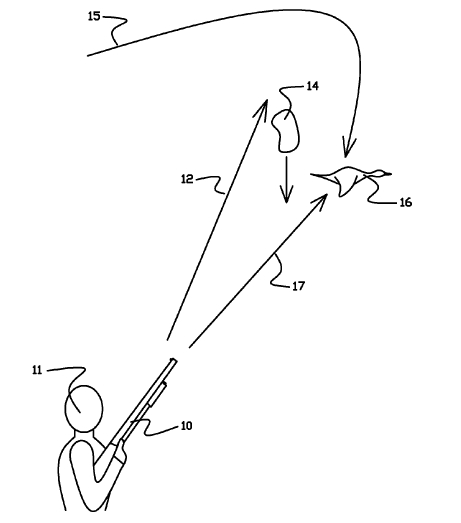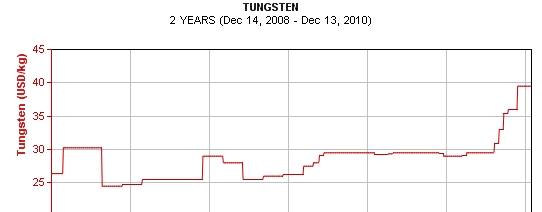


Picking a “No-Tox” Shotshell: Code Words, Misinformation, and Hyperbole
The
idea that shotshells are sold under a dark cloud of hazy misinformation
is not at all a new thing. Shotshell sellers have long come up with some
incredible ways to try to move shells. There are some really goofy things
out there. Be sure to go to the U.S. Patent Office and read application
#12/060,412 that was filed April 1, 2008. It is called “WATERFOWL
ATTRACTING SHOTGUN SHELLS AND METHOD.” That it was filed on April
Fool's Day is more than appropriate.

From the US Patent Office: "When the weighted material is fired into the air, the material falls back to earth. A speed of at which the weighted material falls and an appearance of the weighted material as it falls are chosen to attract waterfowl. In preferred embodiments, the speed is about a speed that a shot waterfowl falls after being shot or a live waterfowl lands, and the appearance is a fluttering appearance. Each waterfowl attracting shotgun shell can include one piece of weighted material or plural pieces. In use, one or more waterfowl attracting shotgun shells can be loaded into a shotgun along with regular shotgun shells."
Code words and misleading terms are not at all new to shotshells. We have the mysterious (and meaningless) “Dram Equivalent,” particularly “Magnum Dram Equivalent” and “Max Dram Equivalent.” Black powder dram equivalents were first introduced long after black powder was no longer commercially loaded in shotshells. It is very hard to have an equivalent when black powder itself varies greatly by brand and by granulation. It didn't stop the meaningless dram equivalents from being used and still they persist. Not only meaningless, it is dangerous according to Lyman: the worst of both worlds.
Chilled shot, hard shot, magnum shot, field grade shot, and precision shot has no clear definition. If words actually mean things, magnum shot would of course be larger than non-magnum shot. But, it isn't. Hard lead shot must something like really stiff Jello. It is an attempt to point towards antimony content of lead shot, but it doesn't do that very well. Hard shot can mean whatever the manufacturer wants it to mean on any given day.
So it goes with steel shot, though “steel” itself may refer to over 130 different alloys all with different properties. I suppose no one really expects steel shot in shotshells to be of 416 stainless, so it means a cheap iron alloy more or less, having a density of about 7.8 grams per cubic centimeter, or 7.8 g/cc. It has always been dramatically inferior to lead as a shot material, lead being much more dense in the area of 11.34 g/cc as “solid lead,” but lead as provided in shot is somewhat less dense in the order of 11.1 g/cc due to its content of the lighter antimony. All of these densities are approximations.
Steel generally stinks as a shot material, abrasive to forcing cones, chokes, and losing velocity very rapidly compared to lead of the same diameter. It can also rust, not a desirable trait in a waterfowl load or any shotshell load for that matter. It can and is plated or varnished, but you don't have to cut open very many shells to find steel pellets welded together in some way. The fundamentals of shot performance are very well established. Denser shot flies better and has better penetration. Perfectly spherical shot is superior to shot this is not. Moderate muzzle velocity loads invariably pattern more consistently than hyper-velocity loads. For lead, excessive velocity means some shot deformation on initial set-back. For steel and other hard materials, you have more open, more random patterns due to the billiard ball effect, along with more stress, shock, and vibration when being squeezed through a forcing cone and squeezed again through the second forcing cone at the muzzle. Higher muzzle velocities for the same payload also mean unwanted recoil.
At short range, steel is of course lethal to a bird. A lot of things are, but that hardly vindicates a load. No. 7-1/2 lead shot has killed geese at close range, but that hardly makes it desirable or preferable. This same notion of illogic has been used to characterize a .223 Remington, a .22-250, and the .220 Swift as wonderful big game cartridges. They aren't. Even though a .22 rimfire has killed steer and deer alike, just because it has been done doesn't make it a good or even acceptable choice.
Shotshell sellers have tried to convince consumers that their lead shells are better than the others, so why wouldn't you expect the same from steel? Certainly, there are differences you can readily observe on the pattern board due to rounder, harder lead, nickel plating, buffering, and better wads. The only problem is that high-antimony shot, premium wads, nickel-plating, and buffering make a shell cost more and we don't like that, generally preferring the cheapest thing that goes bang.
There have been attempts to up the food chain from the 7.8 g/cc steel, such as the sometimes brittle bismuth that has run 9.6 g/ cc, the equally lackluster 9.8 g/ cc Hevi-Shot Duck, the similar density Hevi-Shot Classic Doubles, the 9.4g / cc Hevi-Steel, and other variants that fail compared to lead. On the other end we have the spectacularly dense Tungsten Super Shot that is now spectacularly out of business.
There are better materials, but they come at a price. It can hardly be blamed solely on the manufacturers. An important component of most high-density shot materials is tungsten. A look at the price of tungsten over the last two years helps explain why the better shot materials are currently very costly to produce.

Kent Tungsten-Matrix has long been a standout performer in a dozen of my regular test guns, as close to lead as could be hoped for and easy on vintage barrels as well. But, the price is a turnoff to many shooters, though the 10.8g/ cc Tungsten-Matrix gets very close to the lead shot arena of about 11.1g/cc. Nice Shot, which I have but have not patterned as of yet, is a slight notch back in density at 10.3 g/ cc.
Next, we have a large number of “HD” loads that all run in the same, actually more dense than lead density range of 12g / cc. Are you ready? They include Hevi-Shot Goose and the reportedly “new” Hevi-Shot Duck. How the consumer could tell the difference between the old and new Hevi-Shot Duck is an open question, as is why Hevi-Shot Duck even exists if it is indeed the same as Hevi-Shot Goose. Also in the same range of 12 g/ cc is (apparently) bulk Hevi-Shot, Remington HD, and the Winchester HD loads. Of these five 12g/ cc denisity products, as you've likely already guessed, even though they are the same density the case will be made that they are dramatically different than the others. There are differences, to be sure, in wadding, propellant, hull, sphericity, and buffering. Personally to date, I've found the Winchester HD to be the best of the bunch at the patterning board. As always, shooting your individual gun at the ranges you intend to shoot at with the chokes you intend to use reveals what your gun likes the best for your use. There really is no shortcut to that, but if you want to shoot blind and try to grade patterns on your anecdotal evidence of whacking ducks at unverified ranges and random angles that's up to you.
The densest shot material in circulation is Federal Heavyweight at 15 g/ cc. It is has proven to be fabulously good as discussed and shown in several previous articles. Nothing compares with it in 20 gauge, but a 1-1/2 oz. 20 gauge load while appropriate for turkey isn't likely what you want to shoot in high volume. With the 1-5/8 oz. 12 gauge loads, you might be enticed to use them on Canadian geese. Either way, I can tell you they do an amazingly good job on turkey.
This concludes a brief overview of where we are today, though there is also Fiocchi Tundra and the Winchester “Blind Side” that is touted to hit like bricks which is supposed to be as good as dropping like rain and other fishing lure quality hyperbole. We can all hope for a drop in tungsten prices to help out all the denser loads. Regardless of who offers it, I would not expect shot performance to stray very far from the fundamental rules of density and sphericity. It would take the inventions of both a new branch of both physics and wounding ballistics to allow for that. I don't expect to be testing the “Waterfowl Attracting Shotgun Shells” anytime soon, but it is refreshing to see that those who apply for patents have a sense of humor.
Copyright 2010 by Randy Wakeman. All Rights Reserved.

Custom Search

Custom Search



